With the definition of "input offset voltage" I wanted to find it in simulation for LM358 op amp. Here is the definition: "Input offset voltage is the differential input voltage that would have to be applied to force the opamp's output to zero volts."
In simulation by using 5V dual supply, I swept the non-inverting input from -500uV to +500uV and marked the point where the output becomes zero. Below shows this sweep setup and the plot:

I concluded from the sim that LM358 has around 35uV input offset voltage. Then I go to the data-sheet to verify it. Here what the data-sheet shows:
Typically the input offset voltage should be 2mV. But in sim I get 35uV. This is a big difference, so I wasn't sure what I am doing is correct.
1-) Is my way of measuring input offset voltage correct? If it is correct what could be the reason there is such big difference?
2-) I have found LM358 OPERATIONAL AMPLIFIER "MACROMODEL" SUBCIRCUIT. Where and how is this input offset voltage is mentioned in these SPICE models? Or is it mentioned at all?
Here is the macromodel:
**************************************
* LM358 *
**************************************
* LM358 OPERATIONAL AMPLIFIER "MACROMODEL" SUBCIRCUIT
* CREATED USING PARTS RELEASE 4.01 ON 09/08/89 AT 10:54
* (REV N/A) SUPPLY VOLTAGE: +/-5V
* CONNECTIONS: NON-INVERTING INPUT
* | INVERTING INPUT
* | | POSITIVE POWER SUPPLY
* | | | NEGATIVE POWER SUPPLY
* | | | | OUTPUT
* | | | | |
.SUBCKT LM358 1 2 3 4 5
C1 11 12 5.544E-12
C2 6 7 20.00E-12
DC 5 53 DX
DE 54 5 DX
DLP 90 91 DX
DLN 92 90 DX
DP 4 3 DX
EGND 99 0 POLY(2) (3,0) (4,0) 0 .5 .5
FB 7 99 POLY(5) VB VC VE VLP VLN 0 15.91E6 -20E6 20E6 20E6 -20E6
GA 6 0 11 12 125.7E-6
GCM 0 6 10 99 7.067E-9
IEE 3 10 DC 10.04E-6
HLIM 90 0 VLIM 1K
Q1 11 2 13 QX
Q2 12 1 14 QX
R2 6 9 100.0E3
RC1 4 11 7.957E3
RC2 4 12 7.957E3
RE1 13 10 2.773E3
RE2 14 10 2.773E3
REE 10 99 19.92E6
RO1 8 5 50
RO2 7 99 50
RP 3 4 30.31E3
VB 9 0 DC 0
VC 3 53 DC 2.100
VE 54 4 DC .6
VLIM 7 8 DC 0
VLP 91 0 DC 40
VLN 0 92 DC 40
.MODEL DX D(IS=800.0E-18)
.MODEL QX PNP(IS=800.0E-18 BF=250)
.ENDS
*
Edit:
32V Common mode voltage added; the result agrees with the data-sheet:

